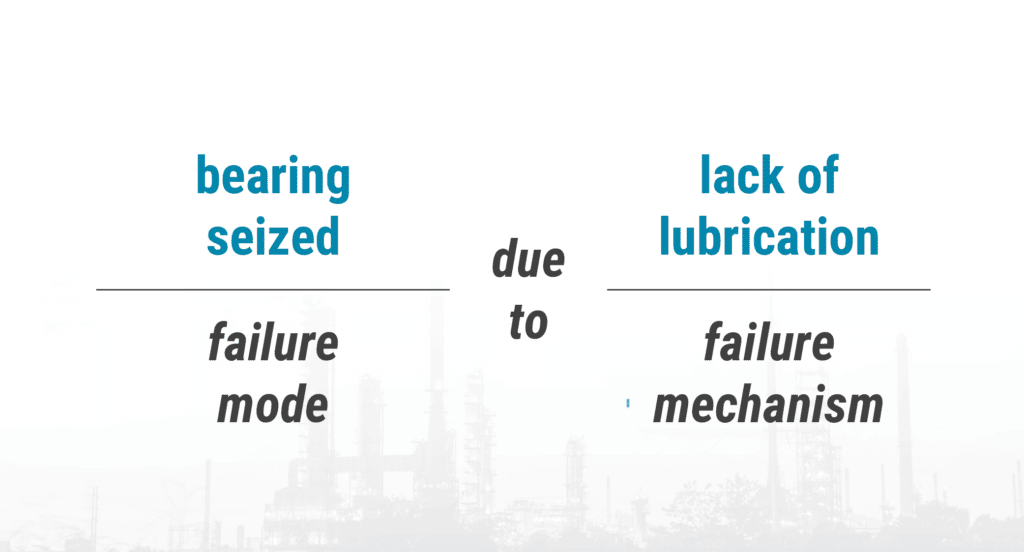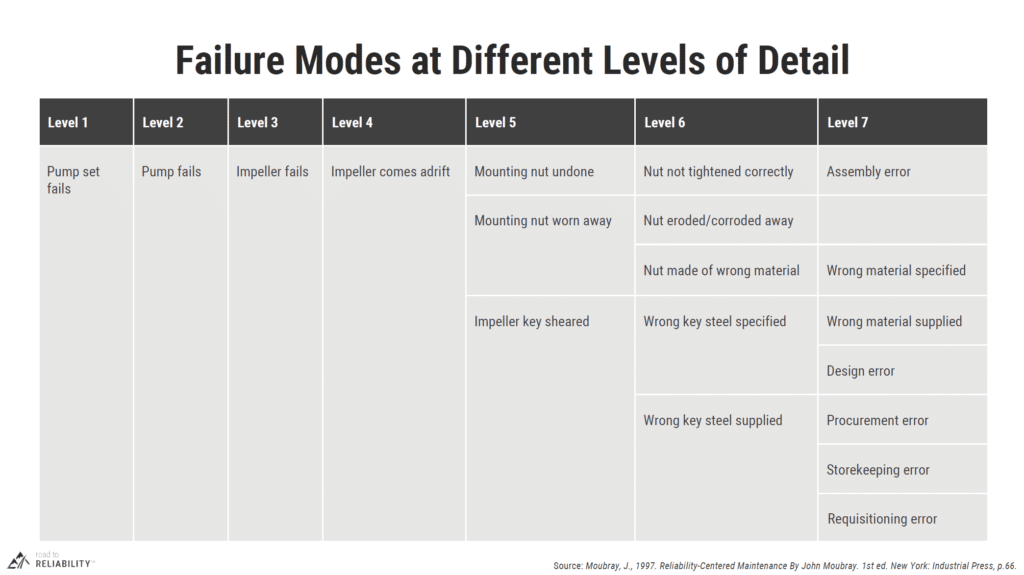When dealing with preventive maintenance, there are 4 concepts that you need to understand and apply to create an effective and efficient Preventive Maintenance program.
- Failure
- Functional Failure
- Failure Mode
- Failure Mechanism
If you’re a maintenance practitioner, you’ve probably heard of these terms numerous times. But let’s go back to basics and clearly define what they are. In the absence of common industry definitions for these terms, I’m going to refer to the definitions used by Moubray in his book, RCM II. I’m also going to refer to some of the definitions used by the IEC, the International Electrotechnical Commission, which has developed a number of pretty good standards in the areas of maintenance and reliability.
Failures
It’s clear what a typical failure looks like. If you have a pump that’s not pumping, then that’s clearly a failure, right? But when we’re talking about preventive maintenance, we’re not just dealing with equipment that’s already stopped working. That has completely or catastrophically failed. We often need to think a bit more nuanced about failure. Here’s what I mean.
Let’s say a pump is delivering 700 liters of water per minute. But it’s designed to deliver 1000 liters per minute. Is the pump failing? Well… it hasn’t completely failed, right? It’s still pumping water. But if our process requires 1000 liters of water per minute…and our pump is still only delivering 700L/min… Then it’s failing to meet the requirements of our process. This is what we call a Functional Failure.
Functional Failures
To put it simply, a functional failure is when the equipment is not doing what you want it to do. (or it’s doing something that it’s NOT supposed to be doing) This distinction is important because equipment often have multiple functions. It can fail to deliver on those functions in multiple ways. And each ‘functional failure’ can have different consequences. This is key in creating an effective and efficient Preventive Maintenance Program. Here’s why.
Let’s say our pump has 2 simple functions:
- Delivering 1000l/min of water
- Containing the water so there are no leaks.
If our pump was delivering water for firefighting… the inability to deliver enough water at sufficient pressure would be a major safety concern. However, if the pump failed to contain all that water, and we had a minor leak of potable water, we might not be that worried. See the difference?
An effective PM program accounts for these different consequences and puts scarce resources into high-risk failures. That’s why in Preventive Maintenance, when talking about “failures”…
What we really need to talk about are functional requirements that are not being met. Because an effective and efficient preventive maintenance program does NOT try to prevent all failures.
Many organisations that don’t understand this end up doing way too many PMs. PMs that aren’t really necessary. In fact, research and experience shows that up to 60% of Preventive Maintenance tasks are adding little to no value to your organisation. Now…
This brings me to the next topic: Failure Modes and Failure Mechanisms.
Failure Modes
A failure mode is simply any event that causes a functional failure. The best way to phrase a failure mode is by combining a noun with a verb. Something like “Bearing Seized” or “Impeller Worn”. Avoid using generic verbs like fails, malfunctions, breaks because they really don’t give you much to work with. For example, if you’re dealing with a coupling, you don’t want to write your Failure Mode as ‘coupling fails’. Instead, you want to get specific with something like, ‘coupling bolts come loose’.
Failure Mechanism
If a Failure Mode is the event which leads to a failure, then the Failure Mechanism is essentially the cause behind the event. A Failure Mechanism is the physical, chemical or other process, which has led to the failure.

An example would be:
Bearing seized due to a lack of lubrication. Bearing seized is the Failure Mode and lack of lubrication is the Failure Mechanism. Now you put the two together by using the phrase “due to”.
Why is this important?
A single Failure Mode may have multiple Failure Mechanisms. And at different levels. You want your failure mode and failure mechanism statement to be clear and concise as possible. And you don’t want to put that much detail that you spend a huge amount of time and energy on the analysis process. Because down the line, figuring out what level of detail you need can become an issue.

It can be a bit of an art because what you would consider a Failure Mechanism at the system level could be deemed a Failure Mode when you go down to the subsystem or even component level. This is where you need a bit of experience and iteration in your work.
For example:
At the top level, the Failure Mode could be that the pump set fails, but that’s vague and not very helpful, right? So, if you go down through the levels shown in the diagram, you see that when you get to level four, we probably have a sensible Failure Mode, which is the impeller comes adrift.
An impeller comes adrift due to 3 causes: the mounting nut coming undone, the mounting nut wearing away, or the impeller key has sheared. These are sensible Failure Modes and Failure Mechanisms at level four and level five.
At level seven, we’re really getting into a level of detail that is not helpful and will just create a lot of extra work. The point of showing this here is so you understand that there are indeed different levels of detail that you can go to, and that it depends on the Failure Mode and the context on how far you want and need to take this.
And the simple rule is that you only go as far as you need to go, to be able to develop an effective failure management structure. That’s obviously easier said than done, and it’s going to take time and experience and some trial and error to figure that out.
The good news is…
If you want to learn how to develop and improve your Preventive Maintenance Programs for your organisation so that you have a system of identifying which Failure Modes and Failure Mechanisms should matter for your organisation…
Then this is for you. In the coming weeks, we will be launching our NEW COURSE: PM100: Developing and Improving Preventive Maintenance Programs
The course focuses on teaching you the principles and practices you need to achieve higher reliability and availability whilst doing LESS maintenance. Poor PM programs waste time and money, do not effectively address failures, and drive our organisations into a reactive, fire-fighting culture.
This course will teach you how to identify these non-value-adding tasks and either improve them or eliminate them. In the meantime, you can learn more about preventive maintenance by reading this article on the 9 Principles of a modern preventive maintenance program below.


